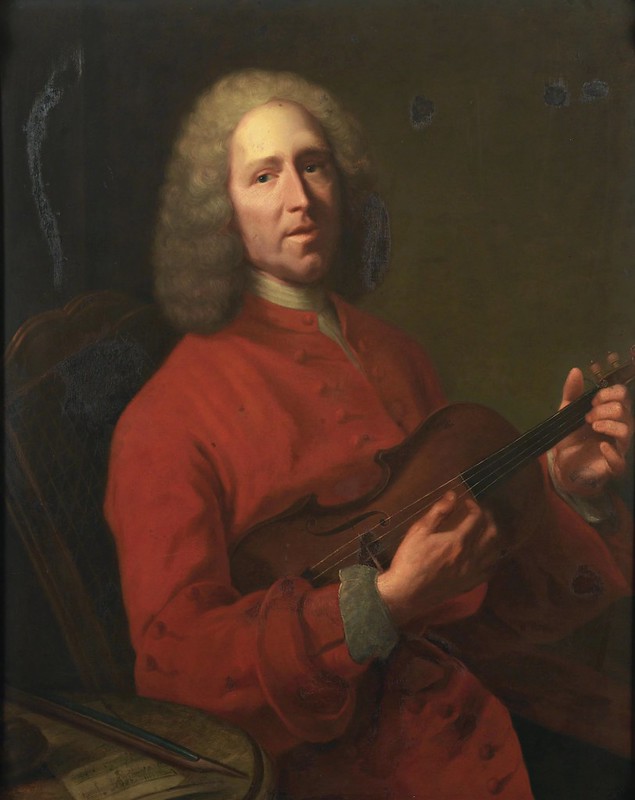Jean-Philippe Rameau (1683-1764)
- Suite from 'Les Surprises de l'Amour' (1748)
Performers: Lamoreux Orchestra; Marcel Couraud (1912-1986, conductor)
Painting: Dans le goût de Jacques-André-Joseph Aved (1702-1766) - Portrait de Jean-Philippe Rameau (1683-1764)
Further info: Jean-Philippe Rameau (1683-1764) - Deus Noster refugium
---
French composer and theorist. He was one of the greatest figures in
French musical history, a theorist of European stature and France's
leading 18th-century composer. He made important contributions to the
cantata, the motet and, more especially, keyboard music, and many of his
dramatic compositions stand alongside those of Lully and Gluck as the
pinnacles of pre-Revolutionary French opera. Details about Rameau’s life
before 1722, when he moved permanently from Dijon to Paris, are
sketchy, partly owing to his own reticence. He was the seventh child and
eldest surviving son of Jean Rameau, organist in Dijon, and Claudine
Demartinécourt. He may have studied music with the organist at the
Sainte Chapelle in Dijon, Claude Derey, and he eventually enrolled in
the Jesuit Collège des Godrans, where he first encountered musical
theater. In 1701 or 1702, he spent a brief time in Italy and then took
up the post of organist of the Clermont Cathedral in May 1702. Next, he
moved to Paris in 1706, became organist at the Jesuit Collège Louis-le-
Grand and to the Pères de la Merci, and published Premier Livre de
Pièces de Clavecin. In 1709, he returned to Dijon to succeed his father
as organist of Notre Dame and then to Lyons in 1713 to be chief organist
of the city. In 1715, he was reappointed at Clermont Cathedral, where
he began work on the Traité de l’Harmonie. His first decade in Paris was
consumed with publishing his new book, which would become famous all
over Europe, two more collections of keyboard music in 1724 and 1729,
and teaching. Oddly, Rameau was not able to secure a major position as
organist anywhere in Paris until 1732, when he became organist at Sainte
Croix-de-la-Bretonnerie. He married a talented singer, 19-year-old
Marie-Louis Mangot, on 25 February 1726. She would bear him four
children and sing in some of his operas. Rameau’s first attempt at a
full-scale opera, Hippolyte et Aricie, opened in 1733 and immediately
ignited that kind of intellectual controversy that could only happen in
France.
His proponents, the ramistes, admired the opera’s adventurous harmonies
and more realistic dramaturgy, while the opposing lullistes, motivated
perhaps by jealousy and fear that their namesake might be eclipsed,
railed against its Italianisms and harmonic complexity. The controversy
persisted through the 1730s and encompassed Rameau’s second opera, Les
Indes Galantes, which saw 64 performances in two years, and especially
his fifth, Dardanus. From sometime in the mid-1730s until 1753, Rameau
was attached to the household of one of the richest men in France,
Alexandre Le Riche de La Poupelinière. La Poupelinière, a financier, was
a great patron of the arts and all manner of writers, actors, and
cultural figures would meet at his house. The attachment advanced
Rameau’s operatic career considerably, since he met some of his many
librettists there. After a fallow period in the early 1740s, Rameau
seems to have caught the attention of the French court. In 1745, he
received three commissions for theater works, including the opera for
the Dauphin’s wedding, La Princesse de Navarre, with a libretto of
Voltaire. On May 4, he was rewarded with an annual pension of 2,000
livres and the title compositeur de la musique de la chambre du roy, a
singular honor for a musician not officially appointed at the court.
These commissions began a train of nine works for the stage composed
between 1745 and 1749. Rameau’s operas so dominated Paris at this time
that the management of the Paris opera felt compelled to restrict the
offerings of Rameau to only two operas per year, in order to give
younger composers a chance. Despite his fame as a thinker about music,
Rameau was never elected to the Académie Royale des Sciences, a
disappointment. Five months before his death, however, he did receive a
patent of nobility from the king, and he died a comparatively wealthy
man three weeks after falling ill with a fever. Many memorial services
in Paris, Dijon, and other provincial cities followed. The first, at the
Pères de l’Oratoire on 27 September 1764, included as many as 180
musicians and was attended by over 1,000 mourners.

Cap comentari:
Publica un comentari a l'entrada